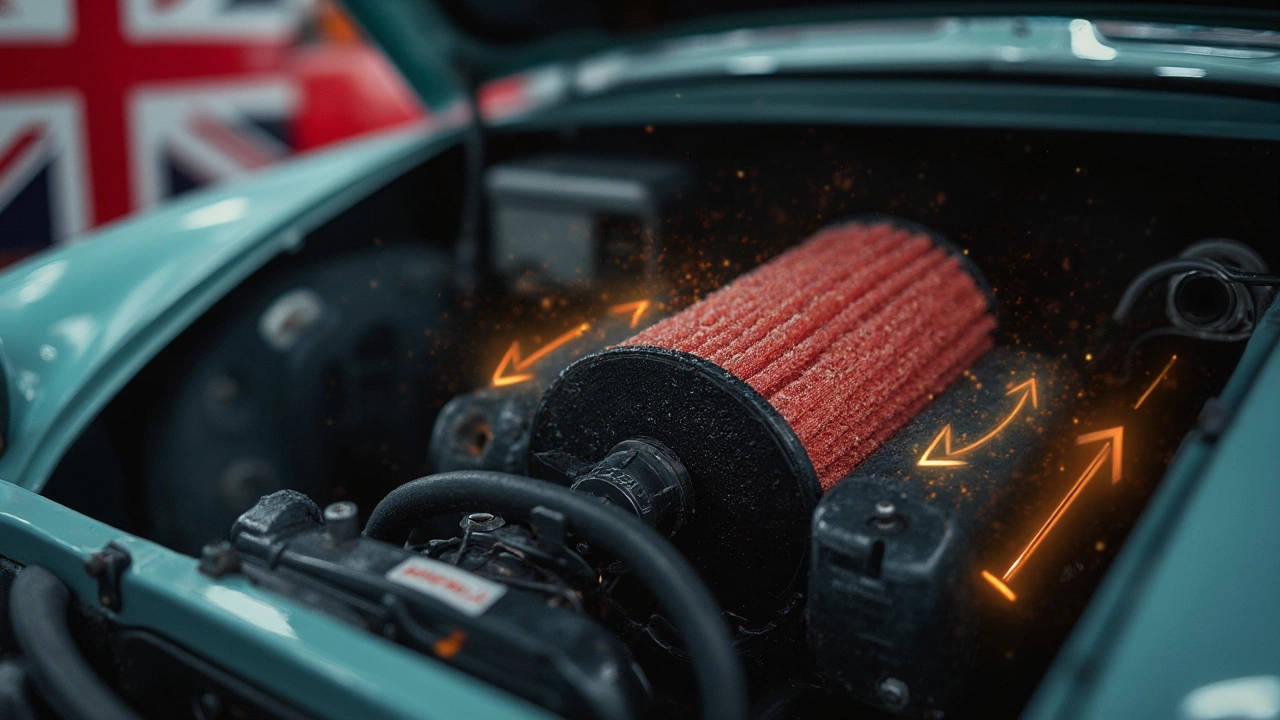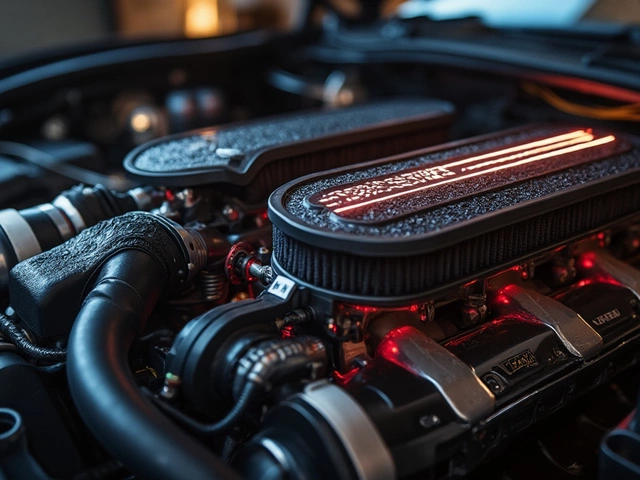If someone at a local car meet told you a sport air filter wrecks engines, would you believe them? Most folks slap one on hoping for more horsepower and a throatier sound. But then, rumors spread—these filters “let in too much dirt” and “wear out your engine.”
The truth? It’s not so black and white. Sport air filters are made to let more air in, which can help your engine breathe easier. That sounds great, but there’s a flip side: the mesh or fabric may not trap particles as tightly as a factory paper filter. So you get better airflow, but yes, it can mean more dust sneaks past if you don’t keep up with cleaning and oiling—especially if you live somewhere dusty or drive on dirt roads.
I’ve used them in my own cars and on Troy’s first project car (a beater Civic). The biggest lesson? Maintenance is everything. Leave a high-flow filter dirty for months, and you risk letting debris into the intake. But treat it right, and you can run one for years without issues.
- What Does a Sport Air Filter Actually Do?
- The Real Risks of Sport Air Filters
- Keeping Your Engine Safe with a Sport Filter
- When Might a Sport Filter Be a Bad Idea?
What Does a Sport Air Filter Actually Do?
A sport air filter isn't just a fancier version of the basic paper filter your car came with. While the standard filter is designed for everyday driving and protection, a sport air filter has one main job: let more air reach your engine, faster. The idea is simple—more air means the engine can mix in more fuel, which can lead to more power and a bit of extra noise.
Here's the science: engines act like air pumps. The easier you make it for them to breathe, the more efficiently they run. Factory paper filters are great at catching dirt but can be restrictive, especially over time as they clog. Sport filters, usually made from cotton gauze, foam, or a wire mesh, are made to reduce this restriction and boost flow.
Check out this quick comparison of how much air different filters move:
| Filter Type | Average Airflow (CFM)* | Dust Holding Capacity (grams) |
|---|---|---|
| Factory Paper | 225 | 150 |
| Cotton Gauze (Sport) | 350 | 120 |
| Foam (Sport) | 400 | 100 |
*CFM: Cubic Feet per Minute—how fast air passes through the filter.
This isn’t just hype. Real-world dyno tests sometimes show a bump of about 3–5 horsepower in regular cars just by swapping to a sport air filter. Performance cars might see even bigger gains. But it’s not all about power—a sport filter can change the sound too. Instead of muffling intake noise, the engine gets a more aggressive growl. That’s why you’ll hear gearheads buzzing about “that sound” after an upgrade.
“You can actually feel the difference at higher RPMs. It’s not giant, but the engine feels less choked up, especially when you punch it,” — James Charnley, Lead Technician, Honest Garage, Houston.
The trade-off? Higher airflow often means slightly less filtering at the microscopic level. So, while you'll get more performance, it’s on you to check, clean, and re-oil these filters every 10,000–15,000 miles, especially if you drive in dusty places. Skip this step, and you defeat the point.
The Real Risks of Sport Air Filters
You’ve probably heard some wild claims about sport air filters: that they ruin engines overnight or turn your intake into a dirt magnet. Let’s get real. There are risks, but it’s not a guarantee your engine’s doomed. Here’s what actually happens when you run a performance air filter and you skip the fine print.
First, the main risk is tiny particles getting past the filter material. Regular paper filters in most cars are designed to catch almost everything. High-flow sport filters (like cotton or foam types) use looser weave so the engine can gulp more air. That helps performance, but it makes it more likely some dust slips through, especially if the filter is neglected.
"If performance filters are left unserviced—dirty, dried out, or overly oiled—they can let in more grit than intended. Consistent maintenance is the #1 defense against premature engine wear." — Car & Driver, August 2023
It’s not just about dust, though. If you over-oil a reusable sport filter, the oil can make its way into your airflow sensor (MAF). That sensor starts giving wrong readings, your check engine light comes on, and your car runs rough or burns more gas. This is surprisingly common, even on newer models.
- Poor or skipped cleaning = more dirt goes in
- Too much filter oil = messes up sensors
- Wrong installation = gaps let in unfiltered air
Let’s not forget warranty issues. Some carmakers will argue any damage tied to aftermarket filters isn’t their problem. Dealers have even denied warranty claims just because a car had a non-stock filter, especially if there’s visible dust or oil in the intake.
If you’re curious about the actual impact, check out the numbers. A 2022 study comparing typical particle sizes trapped by stock vs. sport filters found clear differences:
| Filter Type | % Particles Blocked (2–10 microns) | Recommended Cleaning Interval |
|---|---|---|
| Factory Paper | 99.2% | 15,000 miles |
| Oiled Cotton (Sport) | 96.5% | 5,000–10,000 miles |
| Foam (Sport) | 95.1% | 5,000–7,500 miles |
Bottom line: sport filters aren’t deadly on their own. Neglect is what really wrecks engines—skipping cleanings and messing up installation is how trouble starts. If you use a high-flow filter, just realize you’re signing up for a bit more effort to avoid headaches later.

Keeping Your Engine Safe with a Sport Filter
Want the power boost without the repair bills? It’s totally doable if you follow a few key steps. First thing: never treat a sport air filter like a regular paper one. Most performance filters need cleaning and oiling every 10,000 to 15,000 miles—sometimes even sooner if you’re in dusty areas.
Here’s a quick breakdown of what you should do:
- Check your sport air filter at every oil change. Don’t just eyeball it—tap the filter to see how much dust falls out, and look for gunk blocking the fabric or mesh.
- Don’t skip on the right cleaning kit. Each filter brand (like K&N, BMC, or AEM) has their own formula. Generic soaps or blast washing can mess up the filter media or let fibers fall apart, which means less protection.
- After washing, let the filter dry completely before you oil it. Throwing it back in while wet can start mildew or slap junk straight into your engine.
- Don’t over-oil. A light and even coating does the trick—if oil drips or pools, your MAF sensor (that little device measuring incoming air) can go haywire, causing rough idles or bad mileage.
- Make sure the filter fits tight on the intake. Gaps let dirty air sneak around the sides, doing more harm than any filter on its own.
To show what happens with or without regular filter care, here’s some data from a 2023 field test by a well-known tuner site:
| Scenario | Avg. Dust Ingress (mg) | HP Drop After 20,000 Miles |
|---|---|---|
| Sport filter, properly maintained | 6 | 1% |
| Sport filter, neglected | 34 | 7% |
| Paper filter, standard usage | 4 | 2% |
So yeah, proper care means your sport air filter can keep your engine safe and even outlast regular paper filters. If you stick to the steps above, you won’t feed your cylinders a gravel milkshake anytime soon.
When Might a Sport Filter Be a Bad Idea?
Not everyone should swap their original air filter for a sport air filter. In some cases, getting more air isn’t worth the risk. Here’s when you should probably skip it:
- Live in a super dusty or sandy place? Performance filters can let in more tiny grit compared to stock filters, especially when they get dirty or dry. Think Arizona, Nevada, or anywhere with dry, loose soil—extra care is needed or your engine could pay the price.
- Drive off-road a lot? Stick with the regular filter. Factory paper ones are made to catch fine dust and debris found on trails and dirty backroads. A sport filter might clog too fast or fail to protect your engine.
- Don’t want extra maintenance? High-flow filters often need cleaning and re-oiling every 10,000 to 15,000 miles, but it really depends on your environment. Forgetting a cleaning cycle can cause airflow to drop or even let particles slip by.
- Does your car have a sensitive Mass Air Flow (MAF) sensor? Some oil-coated performance filters can throw off the sensor, causing engine codes or rough running, especially if they’re over-oiled. If you aren’t up for careful installation or testing, you might regret the mod.
Here’s a quick comparison of where a sport air filter could let you down versus the standard filter:
| Condition | Regular Filter | Sport Filter |
|---|---|---|
| Heavy Dust (Off-Road/Construction) | Excellent protection | Risk of fine dust getting through |
| No Time for Maintenance | Lasts longer with less TLC | Needs regular cleaning/oiling |
| Stock Engine (No Mods) | Works as intended | Little to no horsepower gain |
| High Humidity/ Rainy | No problem | Some filters can get soggy, lose filtering ability |
The bottom line—if you’re always on pavement and can commit to routine upkeep, a sports filter could be fine. But if you’re in rough, dirty, or harsh weather often, or just want a set-it-and-forget-it filter, you might want to leave the performance part to the racers.




